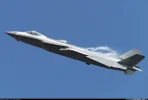In any event, the weapon is much more substantial than is the U.S. military’s own longest-range air-to-air missile, the AIM-120 Advanced Medium-Range Air-to-Air Missile. The AMRAAM is just 12 feet long and seven inches in diameter. The latest version of the American missile, the AIM-120D, reportedly boasts a maximum range in excess of 90 miles.
The new Chinese munition closely matches the dimensions of Russia’s K-100 air-to-air missile, which has been in halting development for 25 years now but could, in theory, hit targets as far as 200 miles from the launching plane.
To achieve its apparent long range, the Chinese VLRAAM reportedly relies on a powerful rocket motor than can propel the munition at “hypersonic” speeds of up to Mach 6 — half-again faster than the AIM-120D’s own top speed.
Launched by a fighter flying as high as 50,000 feet, the Chinese missile could climb to an altitude of around 100,000 feet and glide in the thin air for more than a hundred miles before descending to strike its target — this according to recent studies in Chinese scientific journals, which
Popular Science helpfully pointed out.
A U.S. F-35 fires an AIM-120. U.S. Navy photo
Moreover, Beijing’s VLRAAM reportedly features an active electronically-scanned array seeker with optical back-up and mid-course satellite guidance — truly state of the art for an air-to-air missile. The AIM-120D makes do with an older-style, and less effective, mechanically-steered radar.
Of course, a very-long-range missile is useless in the absence of good targeting. Unless you’re willing to destroy every airplane within reach — whether they’re enemy warplanes, civilian passenger jets or even friendly forces — you need to identify opposing planes before attacking them.
The identification problem prevented the U.S. Navy from successfully deploying its own AIM-54 Phoenix long-range air-to-air missile in combat. The Navy retired the munition in 2004 in favor of cheaper and more practical AMRAAMs.






















